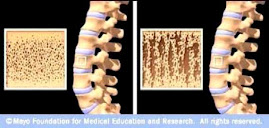Japanese researchers have published several
articles on vitamin K2, such as the following one: “Vitamin K2
(Menatetrenone) Effectively Prevents Fractures and Sustains Lumbar Bone Mineral
Density in Osteoporosis” American researchers have been unable to
duplicate the results. One study found that “Vitamin K Treatment Reduces
Undercarboxylated Osteocalcin but Does Not Alter Bone Turnover, Density, or
Geometry in Healthy Postmenopausal North American Women.”
Each study has weaknesses.
For example, the Japanese researchers did
not use placebo capsules for vitamin K2 in the control group. Therefore,
they cannot exclude the possibility that this may have differentially affected
the behavior of study participants in the control and treatment groups,
although they consider this possibility unlikely. Limitations of the study on
North American women include the relatively short (1 yr) study duration and the
inclusion of only healthy women. Thus, the exclusion of osteoporotic women and,
importantly, the short duration of this study prohibited use of fracture
reduction as a study endpoint.
Here are the two abstracts
with links to the full articles:
Abstract
to Asian Article:
We attempted to investigate whether
vitamin K2 (menatetrenone) treatment effectively prevents the
incidence of new fractures in osteoporosis. A total of 241 osteoporotic
patients were enrolled in a 24-month randomized open label study. The control
group (without treatment; n = 121) and the vitamin K2–treated
group (n = 120), which received 45 mg/day orally vitamin K2,
were followed for lumbar bone mineral density (LBMD; measured by dual-energy
X-ray absorptiometry [DXA]) and occurrence of new clinical fractures. Serum
level of Glu-osteocalcin (Glu-OC) and menaquinone-4 levels were measured at the
end of the follow-up period. Serum level of OC and urinary excretion of
deoxypyridinoline (DPD) were measured before and after the treatment. The
background data of these two groups were identical. The incidence of clinical
fractures during the 2 years of treatment in the control was higher than the
vitamin K2–treated group (χ2 = 10.935; p =
0.0273). The percentages of change from the initial value of LBMD at 6, 12, and
24 months after the initiation of the study were −1.8 ± 0.6%, −2.4 ± 0.7%, and
−3.3 ± 0.8% for the control group, and 1.4 ± 0.7%, −0.1 ± 0.6%, and −0.5 ± 1.0%
for the vitamin K2–treated group, respectively. The changes in LBMD
at each time point were significantly different between the control and the
treated group (p = 0.0010 for 6 months, p = 0.0153 for 12 months,
and p = 0.0339 for 24 months). The serum levels of Glu-OC at the end of
the observation period in the control and the treated group were 3.0 ± 0.3
ng/ml and 1.6 ± 0.1 ng/ml, respectively (p < 0.0001), while the serum
level of OC measured by the conventional radioimmunoassay (RIA) showed a
significant rise (42.4 ± 6.9% from the basal value) in the treated group at 24
months (18.2 ± 6.1% for the controls; p = 0.0081). There was no
significant change in urinary DPD excretion in the treated group. These
findings suggest that vitamin K2 treatment effectively prevents the
occurrence of new fractures, although the vitamin K2–treated group
failed to increase in LBMD. Furthermore, vitamin K2 treatment
enhances γ-carboxylation of the OC molecule. http://onlinelibrary.wiley.com/doi/10.1359/jbmr.2000.15.3.515/full
Abstract
to North American Article
Low vitamin K status is associated
with low BMD and increased fracture risk. Additionally, a specific menaquinone,
menatetrenone (MK4), may reduce fracture risk. However, whether vitamin K plays
a role in the skeletal health of North American women remains unclear.
Moreover, various K vitamers (e.g., phylloquinone and MK4) may have differing
skeletal effects. The objective of this study was to evaluate the impact of
phylloquinone or MK4 treatment on markers of skeletal turnover and BMD in
nonosteoporotic, postmenopausal, North American women. In this double-blind,
placebo-controlled study, 381 postmenopausal women received phylloquinone (1 mg
daily), MK4 (45 mg daily), or placebo for 12 mo. All participants received
daily calcium and vitamin D3 supplementation. Serum bone-specific
alkaline phosphatase (BSALP) and n-telopeptide of type 1 collagen (NTX) were
measured at baseline and 1, 3, 6, and 12 mo. Lumbar spine and proximal femur
BMD and proximal femur geometry were measured by DXA at baseline and 6 and 12
mo. At baseline, the three treatment groups did not differ in demographics or
study endpoints. Compliance with calcium, phylloquinone, and MK4 treatment was
93%, 93%, and 87%, respectively. Phylloquinone and MK4 treatment reduced serum
undercarboxylated osteocalcin but did not alter BSALP or NTX. No effect of
phylloquinone or MK4 on lumbar spine or proximal femur BMD or proximal femur
geometric parameters was observed. This study does not support a role for
vitamin K supplementation in osteoporosis prevention among healthy,
postmenopausal, North American women receiving calcium and vitamin D
supplementation. http://onlinelibrary.wiley.com/doi/10.1359/jbmr.081254/full



No comments:
Post a Comment